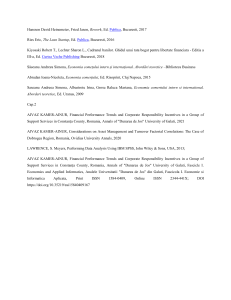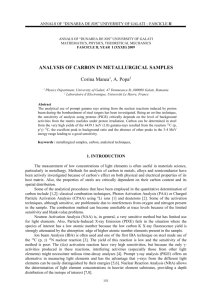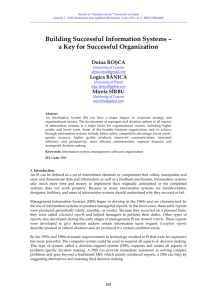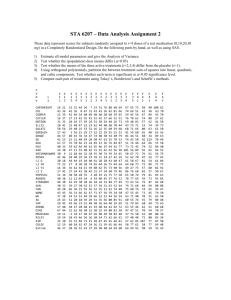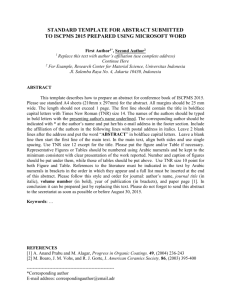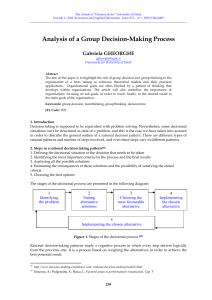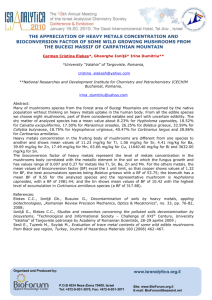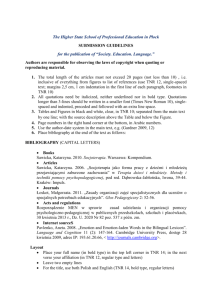Typesetting Instructions
advertisement
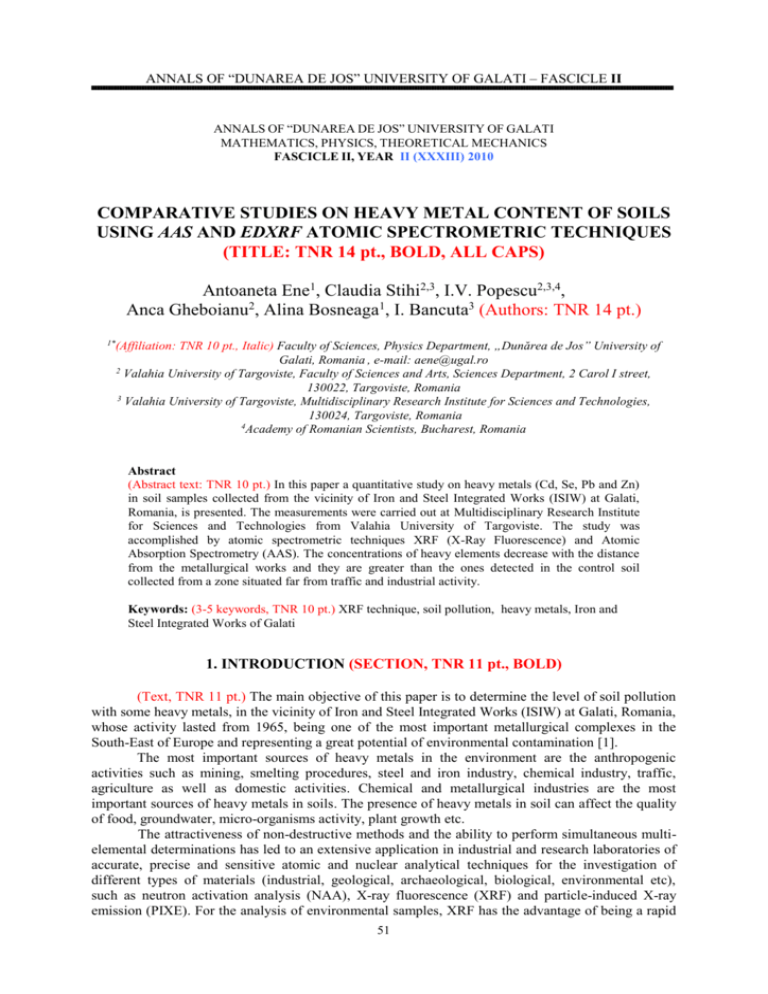
ANNALS OF “DUNAREA DE JOS” UNIVERSITY OF GALATI – FASCICLE II █████████████████████████████████████████████████████████████████████████████████████████████████████████████████████████████████████████████████████████████████████████████████████████████████████████████████ . ANNALS OF “DUNAREA DE JOS” UNIVERSITY OF GALATI MATHEMATICS, PHYSICS, THEORETICAL MECHANICS FASCICLE II, YEAR II (XXXIII) 2010 COMPARATIVE STUDIES ON HEAVY METAL CONTENT OF SOILS USING AAS AND EDXRF ATOMIC SPECTROMETRIC TECHNIQUES (TITLE: TNR 14 pt., BOLD, ALL CAPS) Antoaneta Ene1, Claudia Stihi2,3, I.V. Popescu2,3,4, Anca Gheboianu2, Alina Bosneaga1, I. Bancuta3 (Authors: TNR 14 pt.) 1* (Affiliation: TNR 10 pt., Italic) Faculty of Sciences, Physics Department, „Dunărea de Jos” University of Galati, Romania , e-mail: aene@ugal.ro 2 Valahia University of Targoviste, Faculty of Sciences and Arts, Sciences Department, 2 Carol I street, 130022, Targoviste, Romania 3 Valahia University of Targoviste, Multidisciplinary Research Institute for Sciences and Technologies, 130024, Targoviste, Romania 4 Academy of Romanian Scientists, Bucharest, Romania Abstract (Abstract text: TNR 10 pt.) In this paper a quantitative study on heavy metals (Cd, Se, Pb and Zn) in soil samples collected from the vicinity of Iron and Steel Integrated Works (ISIW) at Galati, Romania, is presented. The measurements were carried out at Multidisciplinary Research Institute for Sciences and Technologies from Valahia University of Targoviste. The study was accomplished by atomic spectrometric techniques XRF (X-Ray Fluorescence) and Atomic Absorption Spectrometry (AAS). The concentrations of heavy elements decrease with the distance from the metallurgical works and they are greater than the ones detected in the control soil collected from a zone situated far from traffic and industrial activity. Keywords: (3-5 keywords, TNR 10 pt.) XRF technique, soil pollution, heavy metals, Iron and Steel Integrated Works of Galati 1. INTRODUCTION (SECTION, TNR 11 pt., BOLD) (Text, TNR 11 pt.) The main objective of this paper is to determine the level of soil pollution with some heavy metals, in the vicinity of Iron and Steel Integrated Works (ISIW) at Galati, Romania, whose activity lasted from 1965, being one of the most important metallurgical complexes in the South-East of Europe and representing a great potential of environmental contamination [1]. The most important sources of heavy metals in the environment are the anthropogenic activities such as mining, smelting procedures, steel and iron industry, chemical industry, traffic, agriculture as well as domestic activities. Chemical and metallurgical industries are the most important sources of heavy metals in soils. The presence of heavy metals in soil can affect the quality of food, groundwater, micro-organisms activity, plant growth etc. The attractiveness of non-destructive methods and the ability to perform simultaneous multielemental determinations has led to an extensive application in industrial and research laboratories of accurate, precise and sensitive atomic and nuclear analytical techniques for the investigation of different types of materials (industrial, geological, archaeological, biological, environmental etc), such as neutron activation analysis (NAA), X-ray fluorescence (XRF) and particle-induced X-ray emission (PIXE). For the analysis of environmental samples, XRF has the advantage of being a rapid 51 ANNALS OF “DUNAREA DE JOS” UNIVERSITY OF GALATI – FASCICLE II █████████████████████████████████████████████████████████████████████████████████████████████████████████████████████████████████████████████████████████████████████████████████████████████████████████████████ . and inexpensive method with a simple sample preparation [2,3]. XRF technique is a promising analytical technique for simultaneous determination of chemical composition in different vegetation species as an alternative to the classical destructive analytical methods, such as Atomic Absorption Spectrometry (AAS). This study is part of a partnership project funded by National Plan of Research, Developing and Innovation, of implementation of high precision and sensibility methods for the bio-monitoring of the environmental pollution in South, South-East and Central regions of Romania (Project 72172/2008). 2. EXPERIMENTAL The concentrations of Zn and Pb in the soil samples were determined by Energy Dispersive X-Ray Fluorescence (EDXRF) technique, using the ELVAX spectrometer from Valahia University of Targoviste, having a X-ray tube with Rh anode, operated at 50 kV and 100 µA (Fig. 1). Samples were excited for 300 s and the characteristic X-rays were detected by a multichannel spectrometer based on a solid state Si-pin-diode X-ray detector with a 140 m Be window and a energy resolution of 200eV at 5.9 keV. ElvaX software was used to interpret the EDXRF spectra. The accuracy and precision of the results as evaluated by measuring a certified reference sample. The concentrations of Cd and Se in the samples were determined by AAS using the AVANTA GBC spectrometer from Valahia University of Targoviste, with flame and hollow cathode lamps (HCL). The dried samples were digested in an acid solution using a Berghof MWS-2 microwave digestion system. Fig. 1. ELVAX spectrometer and XRF Excitation Model (Figure caption, TNR 12 pt., italic) 3. RESULTS AND DISCUSSION Cd, Se, Pb and Zn content in the investigated soils is given in Table 2. From the experimental results presented in Table 2 it can be seen that the concentrations of heavy elements decrease with the distance from the metallurgical works and they are greater than the ones detected in the control soil sample collected from a zone situated far from traffic and industrial activity, in the North of the Galati county (control sample No. 5). For the majority of metals, pronounced maximum concentrations for all depths were detected in the locations near the South gate of ISIW, in the prevailing wind direction. The quantitative results revealed that the obtained values for Cd and Se are within the normal legal values and the intervention thresholds for sensitive area (3 mg/kg) according to the Romanian legal levels admitted for the heavy metal content in soils (O.M. 756/03.11.1997). The concentrations of Zn and Pb in the soil samples obtained in this work were compared with those determined by XRF technique using portable spectrometer which were reported elsewhere [3]. 52 ANNALS OF “DUNAREA DE JOS” UNIVERSITY OF GALATI – FASCICLE II █████████████████████████████████████████████████████████████████████████████████████████████████████████████████████████████████████████████████████████████████████████████████████████████████████████████████ . Table 2. Heavy metal content in the investigated soils (Table title, TNR 12 pt.) Soil No. 1 Depth (cm) 0 5 2 0 5 3 0 5 4 0 5 5 0 5 6 0 5 7 0 5 8 0 5 Nd – non detectable * this work ** reported results [3] Cd* (mg/kg) x x x x x x x x x x x x x x x x Se* (mg/kg) x x Nd 0.40 x x x x Nd 0.54 Nd 0.86 x x x x Zn* (mg/kg) x x x x x x x x x x x x x x x x Pb* (mg/kg) x x x x x x x x x x x x x x x x Zn** (mg/kg) x x x x x x x x x x x x x x x x Pb** (mg/kg) x x x x x x x x x x x x x x x x The classical steady-state acceleration response can be expressed as follows. a= Wp W sin 2ft (1) 2 f 0 2 f 0 2 1 2 f f where: f is forcing frequency, f0 natural frequency of the spring-mass system, β damping ratio, W mass weight, Wp weight of the person, α the ratio of the dynamic component of loading to the person's weight, referred to as the dynamic load factor. 4. CONCLUSIONS AAS and EDXRF techniques have been employed in order to evaluate the pollution of soil with heavy metals in the vicinity of Iron and Steel Integrated Works (ISIW) at Galati, Romania, which is one of the most important metallurgical complexes in the South-East of Europe. From the experimental results presented in this work it can be seen that the concentrations of heavy elements decrease with the distance from the metallurgical works and they are greater than the ones detected in the control soil collected from a zone situated far from traffic and industrial activity. For the majority of metals, pronounced maximum concentrations for all depths were detected in the locations near the South gate of ISIW, in the prevailing wind direction. The comparison of the soil heavy metal concentrations with the maximum values admitted by the Romanian guideline has also been made. The soils located in influence zones of industrial objectives with ferrous processing activities recorded heavy metals loading (contamination) or pollution. References 53 ANNALS OF “DUNAREA DE JOS” UNIVERSITY OF GALATI – FASCICLE II █████████████████████████████████████████████████████████████████████████████████████████████████████████████████████████████████████████████████████████████████████████████████████████████████████████████████ . 1. Ene A., Popescu I. V., Ghisa V., Study of transfer efficiencies of minor elements during steelmaking by neutron activation technique, Rom. Reports Phys. 61(1), 165, 2009. 2. Bosneaga A., Georgescu L.P., Ene A., Soil pollution with heavy metals in Galati region, Annals Dunarea de Jos Univ. Galati, Fascicle II, Year XXXII, 41, 2009. 3. Ene A., Bosneaga A., Georgescu L., Determination of heavy metals in soils using XRF technique, Rom. Journ. Phys. 55(7-8), 815, 2010. 4. Thomas B. G., Continuous Casting of Steel, Chapter 15, in: Modeling for Casting and Solidification Processing, (Yu O., editor), Marcel Dekker, New York, pp. 499-540, 2001. 54
